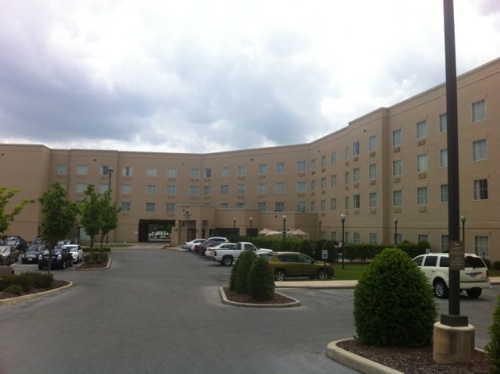 Series Overview
Series Overview
While walkable mixed use town centers may not be the *easy* choice for the asphalt guy, the engineer, or even the developer who has to attract tenants to an environment they may not be as used to… they are certainly becoming best practices for sustainable community development. More importantly, they are quickly becoming a market favorite and a valuable amenity to their adjacent (and integrated) residential neighborhoods. Too often, however, municipalities and developers choose only to commit to this model halfway, viewing it as a niche market with limited potential where quaint mom and pops struggle away (you know, that one-off new urbanist development at the edge of town), while the “real stuff” happens in large conventional single-use centers down the street.
This lack of commitment allows many of the essential ingredients of a successful walkable town center to get sucked into car-focused single-use centers (the easy place to put them) so that everyone can make excuses as to why the poor mixed use village struggles and we still have to do the conventional stuff until oil hits $10 a gallon.
Here begins the first in a Back of the Envelope series where I will make the case for getting those ingredients out of single-use districts and into walkable mixed use town centers. While this may challenge some who think they’ve done their green duty with their one-off TND development down the street, my hope is that it will help make the more important case of focusing our limited economic energies onto places of enduring value, rather than continuing on the big race-to-the-bottom that is the big-box shopping center.
The Hotel: 24 hour Mixed Use Value
This week, we’ll start with the hotel. Now, anyone who travels has likely witnessed the competition-driven rise in chain hotel sophistication over the past decade. With six pillow choices, hot cookies, and free beer, these guys are going all-out. But what happens when you go out the front door? Too often, new hotels are plunked down into the worst of our automobile-oriented sprawl where you take your life into your hands just to walk down the street to the Applebee’s for some jalepeno poppers. While there are some limited cases where you might locate a hotel in this environment, in most cases it is a colossal wasted opportunity. Fortunately, the value-capture of diverting your town’s chain-hotel investments into a walkable town center is symbiotic. Here’s why I like them there:
– A Destination by Foot: For the guest, the obvious amenity is the ability to leave the hotel after you’ve checked in to find an engaging pedestrian environment with lots to eat, drink, and entertain yourself with. If you think about it, I find almost no cases where a weary traveler might want to get back into their car (if they even have one) to go in search of food and entertainment in a strange town. Oh, and when you get back to your room, draw the curtains… its ugly out there.

The Village of Providence in Huntsville, Alabama has a number of hotels now emerging. The Homewood Suites is the building to the left. Here, outdoor seating in a treed plaza serves a number of restaurants.
– Captured Market: The flip side of this is that you are bringing the retail side of your town center an ever-changing captive market. It’s 150 rooms of foot traffic, and it’s valuable.
– Inherently Mixed Use: While one challenge of walkable town centers is to get the vertical mixed use to pencil, the hotel offers a concentrated mixed use building complete with a commercial base (often a restaurant and bar at the base) and 150 plus rooms up above. This is great for shaping urban streetscapes and activating public space. And while your hotel patrons might go somewhere else for dinner, know that you will get non-patrons visiting your food and beverage amenities — something that may rarely happen in single-use environs.

The Homewood Suites is just down from the walkable shopping street in Huntsville’s Village of Providence. Turn right at the sign to check in.

These mixed use business across from the Hotel in the Village of Providence will benefit from the Hotels’ 24 hour population.
– 24 hour population: The hotel offers a built-in 24 hour population bringing life to your town center streets and putting eyes onto the street.
– Iconic Building: While much of your town center may be 1-3 stories, the hotel often has no problem climbing up to four or more stories. With such an investment, the hotel can be an iconic, or at least highly visible structure within the town center. Add some funky signage onto that tower element that us urban designers like to throw into our plans, and you have far-off visibility that rivals the neon highway sign.
– Infrastructure: And lastly (although I’m sure there’s more), dont forget the efficiencies you get with any land use in a mixed use center when you no longer have to build gigantic car-only streets linking disconnected parking lots in transit-repellent wastelands.

The Marriott in Legacy Town Center outside of Dallas provides a dedicated court as a port cochere. Note also the location on a square doubling as a storm pond. (Photo Credit: Bing)

Set amongst mixed use retail and apartments, The Marriot utilizes iconic architecture within the Legacy Town Center outside of Dallas.

A new hotel rises along the main street in the Village of Providence in Huntsville.
Accommodating the Chain Model
As mentioned before, competition is fierce among hotel chains and many of them have their model of operation. But aside from branding, much of this is actually focused within the building. The outside is relatively simple: A shopfront for your food and beverage, a semi-private pool on the sunny side, a port cochere to check in, and a convenient parking lot. And while the hotels have a template for the conventional suburban location, use the rationale above to help motivate them to revisit their model. And know that this is no pipe dream. One of my favourite stories now unfolding is the Village of Providence in Huntsville, Alabama, where a number of hotels are emerging in their walkable town center… and there are many more. Meanwhile, here’s a few ideas to help get you started:
– Get your restaraunts and bars in shopfronts on the commercial street. You’ll also want a branded entry to the hotel here, but it doesn’t have to be the main entrance.
– Just like any use, locate your long-term parking within the block. Good signage, valet service, and directions from the concierge make this an easy task.

The Homewood Suites in the Village of Providence locates long term parking and the pool behind the building. The tunnel through the building serves convenient luggage loading and unloading in a weather protected space.
– Consider a mezzanine level (second storey) to get your fitness center and meeting rooms overlooking the commercial street.
– If you set aside some of the on-street parking for your hotel port cochere, and bring an awning out over the sidewalk, you have the classic Manhattan hotel scene. But that may not be for everyone.
– Consider a turn-in to your port cochere from the main or side street. If it goes through the building (like a tunnel), you have a weather protected port-cochere and it’s under the hotel’s full control. And, of course, link this tunnel to the in-block parking and back-of house services. This is how the first hotel in the Village of Providence handled it.
– Consider a dedicated court for your port cochere like Legacy Town Center outside of Dallas. Again, you get full control, but unless you are a larger hotel, it may be difficult to pull this off, and you may create a large hole in the continuity of a commercial street.
– And lastly, if you want to get real urban, consider locating on a square where your hotel can take advantage of the parking and traffic circulation of one leg of the surrounding street. The most celebrated example, of course, is the Plaza Hotel in Manhattan.

The Plaza Hotel in Manhattan takes up a whole side of the square for loading and unloading. How’s that for inspiration?
Have any other examples or ideas? Post them here! We all want to hear them.
Next up: Get your Shops into a Walkable Town Center
–Geoff Dyer
If PlaceShakers is our soapbox, our Facebook page is where we step down, grab a drink and enjoy a little conversation. Looking for a heads-up on the latest community-building news and perspective from around the web? Click through and “Like” us and we’ll keep you in the loop.











Pingback: Chain Hotels and Walkable Downtowns: A Good Match | APA News Feed
This is a detail inconsequential to the subject matter, but the pond at in Bishop Park at Legacy doesn’t handle storm water detention. There was a stormwater plan in place to send all stormwater runoff to the White Rock creek watershed where there are a series of ponds used for irrigation. The runoff recharges those ponds.
If the pond were to be used for re-/detention it would’ve likely ended up with significant freeboard. The designers/developers intention was for the water be stepped down to and interacted with rather than large concrete walls like at Atlantic Station.
Geof: This is all good advice, and assumes that the hotel operator really wants to be in a certain place. To date, my experience is that towns are so desparate for hotels (as they generate substantial revenue for a city) that they willingness to push back against the standard footprint depends upon how desirable a place they already are. But then I guess that’s true for most things.
In our suburbs there is opportunity to make a place starting with three extended stay hotels. Within block distance are bookstore, one of best coffee shops in town, and an exercise sports complex, probably unknown to hotel residents. wish i could post an air photo.
Reblogged this on Stupidityflowering and commented:
It’s as if I’ve subcontracted out my thoughts and ideas to highly talented writers who churn out one great post after another! These thoughts on hotels are inspiring, to say the least.
Great post and great topic. I recently had a nice stay at a hotel in Raleigh that would’ve been even better if I could actually walk to anything besides other hotels on our dead-end road. I note that hotels might be also be great for town centers where housing isn’t an option because there’s no market or NIMBYs. Housing in a town center is ideal, but hotels also drum up street activity at most hours of the day, just as apartments would.
Excellent post… thanks! I was just at Providence today, and the new hotel is almost complete. Matter of fact, they’re planning their last few buildings of their town center… an amazing success story that almost nobody knows. In today’s climate, they have $40 million of construction underway. People should know this place better!
Thanks for the wonderful post. As a TND developer, my family and I visited The Village of Providence and stayed at the existing hotel in the town center. It was a pleasure to be able to leave our car parked and stroll along the public space to have dinner at one of the nearby restaurants. I’ve very interested in the concept of adding a bed & breakfast or small inn to my next project and wondering if anyone has advise of the market potential of doing so.
Pingback: Community-Based Economic Development | PlaceShakers and NewsMakers
Pingback: Don’t Get Mixed Up on Mixed-Use | PlaceShakers and NewsMakers
Pingback: Get your Multi-Family into a Walkable Town Center! | PlaceShakers and NewsMakers
Walkable hotels that is really a very good idea that i never seen and notice in my life,location is really a big important to any hotels that’s why in Finland country most of their hotels are walkable and near to some beaches,and other center that very convenient for customer.
Pingback: Get Your Offices into a Walkable Town Center! | PlaceShakers and NewsMakers
While I agree with nearly everything you say as best practice, one item I will argue with on the intent of hotels and the uses they serve for a vast majority of the time.. Business travel is a HUGE portion of the overall travel industry. Yes, a weary PERSONAL vacationer doesn’t necessarily want to get back in to a car to drive to eat/see/drink/etc. However, many people stay at a hotel for business travel based solely on convenience – to the airport, their client, or even just a stop at night halfway between one day’s events and the next to give them a head start on driving. This is why we see so many typical “suburban” footprints. For the same reason we don’t want freeways running right through our town centers, the hotels that serve the people who want to wake up and get on the move as quickly as possible want to be as close to freeways as possible.
Now, this isn’t to say the design of the hotels and amenities near the freeways couldn’t be done better – integrating many of the functions you list in to 1 or 2 buildings, and more importantly located closer (within?) to the “end destinations” (office parks). Just a thought.
Pingback: Get your offices into a walkable town center! « Read Centro
Pingback: Sruthi Pathak Bangalore Female Escorts